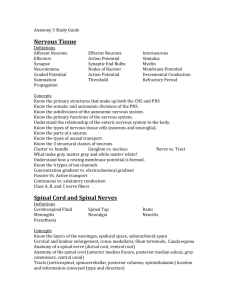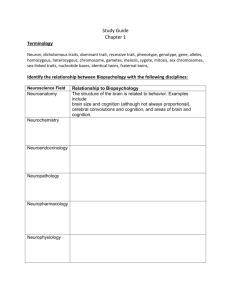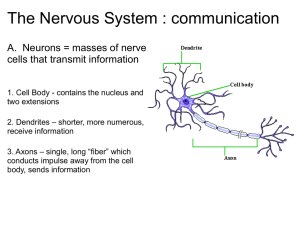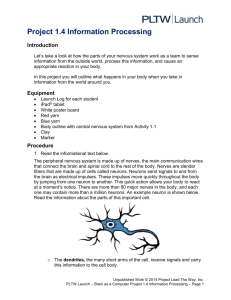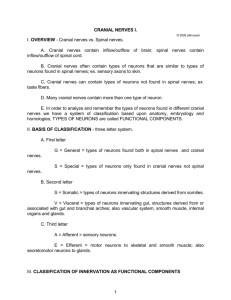Human Anatomy and Physiology 242
advertisement
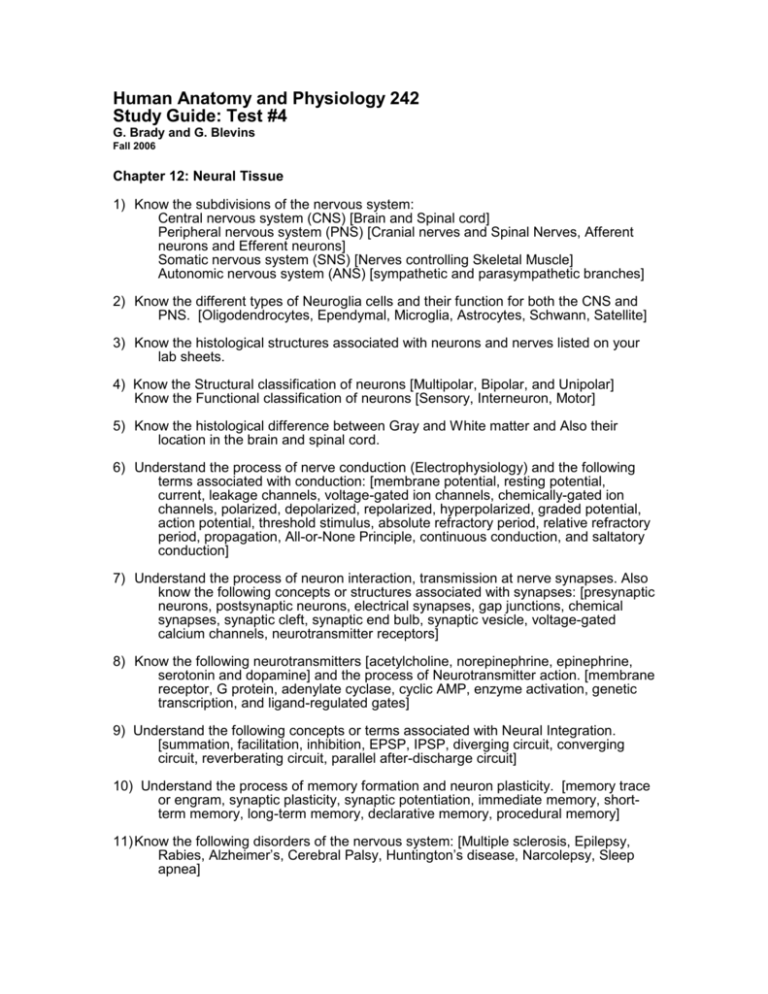
Human Anatomy and Physiology 242 Study Guide: Test #4 G. Brady and G. Blevins Fall 2006 Chapter 12: Neural Tissue 1) Know the subdivisions of the nervous system: Central nervous system (CNS) [Brain and Spinal cord] Peripheral nervous system (PNS) [Cranial nerves and Spinal Nerves, Afferent neurons and Efferent neurons] Somatic nervous system (SNS) [Nerves controlling Skeletal Muscle] Autonomic nervous system (ANS) [sympathetic and parasympathetic branches] 2) Know the different types of Neuroglia cells and their function for both the CNS and PNS. [Oligodendrocytes, Ependymal, Microglia, Astrocytes, Schwann, Satellite] 3) Know the histological structures associated with neurons and nerves listed on your lab sheets. 4) Know the Structural classification of neurons [Multipolar, Bipolar, and Unipolar] Know the Functional classification of neurons [Sensory, Interneuron, Motor] 5) Know the histological difference between Gray and White matter and Also their location in the brain and spinal cord. 6) Understand the process of nerve conduction (Electrophysiology) and the following terms associated with conduction: [membrane potential, resting potential, current, leakage channels, voltage-gated ion channels, chemically-gated ion channels, polarized, depolarized, repolarized, hyperpolarized, graded potential, action potential, threshold stimulus, absolute refractory period, relative refractory period, propagation, All-or-None Principle, continuous conduction, and saltatory conduction] 7) Understand the process of neuron interaction, transmission at nerve synapses. Also know the following concepts or structures associated with synapses: [presynaptic neurons, postsynaptic neurons, electrical synapses, gap junctions, chemical synapses, synaptic cleft, synaptic end bulb, synaptic vesicle, voltage-gated calcium channels, neurotransmitter receptors] 8) Know the following neurotransmitters [acetylcholine, norepinephrine, epinephrine, serotonin and dopamine] and the process of Neurotransmitter action. [membrane receptor, G protein, adenylate cyclase, cyclic AMP, enzyme activation, genetic transcription, and ligand-regulated gates] 9) Understand the following concepts or terms associated with Neural Integration. [summation, facilitation, inhibition, EPSP, IPSP, diverging circuit, converging circuit, reverberating circuit, parallel after-discharge circuit] 10) Understand the process of memory formation and neuron plasticity. [memory trace or engram, synaptic plasticity, synaptic potentiation, immediate memory, shortterm memory, long-term memory, declarative memory, procedural memory] 11) Know the following disorders of the nervous system: [Multiple sclerosis, Epilepsy, Rabies, Alzheimer’s, Cerebral Palsy, Huntington’s disease, Narcolepsy, Sleep apnea] A/P 242 Study Guide Test #4 page 2 Chapter 13: Spinal Cord and Spinal Nerves 1) Know the three principal functions of the Spinal Cord: [Conduction, Locomotion, Reflexes] 2) Know the structures associated with spinal cord listed on the lab handouts. 4) Know the arrangement of the meninges around the brain and spinal cord. [Dura mater, Arachnoid mater, Arachnoid space, Pia mater] 5) Understand what is meant by a reflex arc and know how the components which fit together into a pathway: [Receptor, sensory neuron, integrating center, motor neuron, and effector]. Also, know the specific example of the patellar (stretch) reflex 6) Know the components and connective tissue coverings of a spinal nerve: [epineurium, perineurium, fascicle, endoneurium, nerve fiber] 7) Know the major plexuses of the spinal nerves along with the following nerves: a) plexuses: cervical, brachial, lumbar, sacral b) Nerves: phrenic, axillary, ulnar, median, radial, genitofemoral, femoral, sciatic nerve (tibal, peroneal branches) and pudendal c) Know what the muscles, and genral areas the nerves above innervate. (see lab list) 6). Understand the innervation pattern of spinal nerves based upon the distribution of dermatomes. [page 501] CHAPTER 14: The Brain and Cranial Nerves 1) Know the structures associated with the brain listed on sheets. 2) Know the structures associated with embryonic development of the brain: (primary and secondary vesicles) Primary: prosencephalon, mesencephalon, rhombencephalon Secondary: telencephalon, diencephalon, metencephalon, myelencephalon 3) Know where cerebrospinal fluid (CSF) is produced, how CSF contributes to homeostasis, and the circulation pathway for CSF. Be sure to include the following structures: ependymal cells, choroid plexuses, lateral ventricles, interventricular foramina, third ventricle, cerebral aqueduct, fourth ventricle, central canal, subarachnoid space, arachnoid villi, superior sagittal sinus 4) Know the following structures, and their function, associated with the brain stem: Medulla Oblongata: cardiovascular center, medullary rhythmicity area, cranial nerves (IX, X, Xl, XII) Pons: pneumotaxic area, apneustic area, cranial nerves (V, VI, VII, VIII) Mesencephalon: cerebral peduncles, corpora quadrigemina (superior and inferior colliculi), substantia nigra, , reticular activating system. Reticular formation [somatic motor control, cardiovascular control, pain modulation, sleep and consciousness, habituation] A/P 242, Study Guide: Test # 4 Page 3 5) Know the following structures, and their function, associated with the Diencephalon. Pineal gland: melatonin Thalamus: intermediate mass, medial geniculate nucleus (hearing), lateral geniculate nucleus (vision), ventral posterior nucleus (taste), cognition Hypothalamus: mammillary bodies and infundibulum, and the chief functions of the hypothalamus 6) Know the following structures associated with the cerebellum and the basic function of the cerebellum: arbor vitae, inferior, middle, and superior cerebellar peduncles. 7) Know the following structures, and their function, associated with the Cerebrum: Surface anatomy: cerebral cortex, gyri, sulci, longitudinal fissure, falx cerebri, central sulcus, precentral gyrus, postcentral gyrus, lateral cerebral sulcus, transverse fissure, parieto-occipital sulcus Lobes: frontal, parietal, temporal, occipital, insula Functional Areas: primary auditory area, auditory association area, primary visual area, visual association area, somatosensory association area, primary somatosensory area, primary motor area, premotor area Internal anatomy: corpus callosum, septum pellucidum Know the basic functions of the Basal ganglia and limbic system. 8) Understand the follow concepts associated with higher Froebrain Functions Brain Waves: electroencephalogram, Alpha waves, Beta waves, Theta waves, Delta waves. Sleep: circadian rhythms, suprachiasmatic nucleus, 4 Sleep tages, REM Cognition: contralateral neglect syndrome, agnosia, frontal association area Sensation: somesthetic, special senses, somatotopy, first order neurons, second order neurons, third order neurons. Motor Control: upper motor neurons, lower motor neurons, dyskinesias, Parkinson disease, Huntington disease. Cerebral Lateralization: categorical hemisphere, representational hemisphere 9) Know the information regarding the12 pairs of cranial nerves provided in the Lab handout. Chapter 16: Sense organs. 1) Know the classifications of receptors a) By modality: [chemoreceptors, thermoreceptors, mechanoreceptors, photorecetors, Nociceptors] b) By stimuli: [interoreceptor, proprioceptors, exteroceptors] c) By receptor distribution [general senses, special senses] 2) Understand the following concepts association with Pain perception. [ fast pain, slow pain, somatic pain, visceral pain, bradykinin, referred pain, analgegic, endorphins, substance P] A/P 242, Study Guide: Test # 4 Page 4 Taste Gustation: 3) Know the structures associated with gustatory receptors and the tongue: taste bud, gustatory receptor cells, taste pore, supporting cells, gustatory hair, circumvallate papillae, fungiform papillae, filiform papillae, and foliate papillae. 4) Although it appears that it may be wrong now, but still covered in the textbook, knowthe mapping of the tongue for the four basic tastes: Bitter, Sour, Salty, Sweet Vision: 5). Know the external and accessory structures associated with eye (surface anatomy, internal anatomy, and histology of the retina) listed on the eye lab list. 6). Understand the following concepts associated with image formation by the eye: Refraction of light rays, Accommodation, Near point vision, Presbyopia, Myopia, Hyperopia, Astigmatism, Constriction of the pupil, Convergence. 7). Understand the physiology of photoreceptors: a) The role of Photopigments: Rhodopsin, Opsin, retinal, isomerization, bleaching, retinal isomerase, and regeneration. b) Light and dark adaptation. c) Receptor potential and neurotransmitter release: cyclic GMP, transducin, PDE, guanylate cyclase stimulating factor. 8). Be able to trace to visual pathway from retinal processing to the visual cortex of the brain. (rod/cone, bipolar cell, ganglion cell, optic nerve, optic chiasm, optic tract, lateral geniculate nucleus of the thalamus, optic radiations, primary visual cortex) Auditory: 9). Know the structures associated with ear (External surface anatomy, middle ear anatomy, internal ear anatomy, and histology of the cochlea) listed on Nervous system list. 10). Understand the basic characteristics of sound waves: frequency, pith, intensity, decibels. 11). Understand the physiology of hearing; in other words, know how mechanical sound waves are transmitted and converted into a nerve impulse. Equilibrium: 12). Know the structure of the inner ear associated with equilibrium listed on the Nervous system list given out at the start of the nervous System. 13). Know the difference between static (relationship of your head to gravity) and dynamic equilibrium (linear acceleration). 14). Understand the physiology of the saccule, utricle, and the semicircular ducts. A/P Study Guide: Test # 4 Page 5 Medical terms and disorders: 15). Know the following clinical application, disorders, and medical terms: a) disorders: cataract, glaucoma, nystagmus, vertigo, and Meniere’s disease, conductive deafness, nerve deafness, astigmatism, diabetic retinopathy, glaucoma, hyperopia, myopia, night blindness, nystagmus, otitis media, presbyopia, scotomas, b) medical terminology: anesthesia, hypersthesia, paresthesia Chapter 15: The Autonomic Nervous System 1). Understand the basic differences between the Somatic and Autonomic Nervous Systems. (preganglionic neuron and postganglionic neuron) 2). Know the basic anatomy of the sympathetic and the parasympathetic division: a) Sympathetic (Thoracolumbar): short preganglionic fibers, long posganglionic fibers, sympathetic trunk, paravertebral ganglia, inferior mesenteric ganglion, superior mesenteric ganglion, celiac ganglion. b) Parasympathetic (Craniosacral): long preganglionic fibers, short postganglionic fibers, otic ganglion, submandibular ganglion, pterygopalatine, ciliary ganglion . 3). Know the Neurotransmitter and the specific type of receptors associated with each division of the ANS. 4). Know the major activities or action of the parasympathetic and sympathetic on the major organs.




